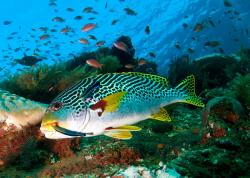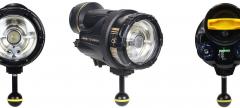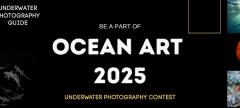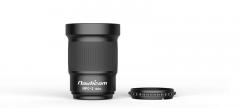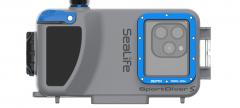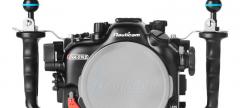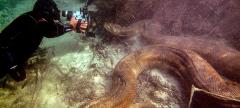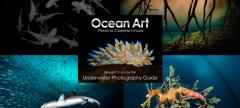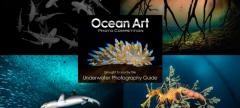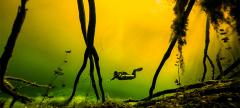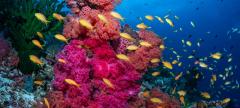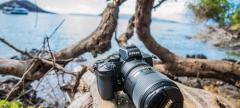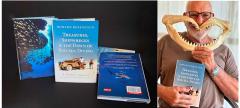Best Dive Destinations for Pelagics, Corals Reefs, Wrecks and Muck
Quick Links
Pelagics | Corals & Reef Diving | Wrecks | Muck Diving
Whales | Exotic Underwater Locations | Sharks
Also be sure to visit our Dive Destination Guide by Location with detailed information about the top 35 dive destinations for underwater photography.

How do you get to your favorite dive destinations? Your editor on the way to a dive site - the "Drop Off", camera on the lap.
There are many great dive destinations in the world for underwater photography. Some are very hard to get to, and some can be quite expensive. This guide will expose you to what I think are some of the best dive areas that are accessible and fairly well known. Your own research may of course turn up new spots.

The golden triangle is filled with excellent photo subjects such as this mantis shrimp in Bali. D300, 60mm lens, F11, 1/200th, ISO 200
Popular underwater photography diving destinations
Popular dive spots in the world for underwater photography include Anilao, Lembeh Strait, Bali, Sipadan, Papau New Guinea, Sulawesi, Raja Ampat, Galapagos, Cocos, Southern California, Monterey, British Columbia and the Red sea.
Bunaken has great wall diving & corals, and some big fish. Siladen has healthy shallow coral reefs and great soft coral.
The Solomon islands has some spectacular reefs, soft corals, mantas, huge sea fans, bumpheads barracudas, and large schools of jacks. Everyone that has been to the solomon islands rates it very highly for underwater photography, especially for corals and schools of fish.

Fuseliers seen while diving Papua New Guinea, photo by Randy Harwood.
Diving the Golden Triangle and Southeast Asia
One of my favorite destinations for diving and underwater photography is the Golden Triangle. This area includes Sipidan, eastern Borneo, Indonesia, Philippines , Papau New Guinea and the Solomon islands. Fish, invertebrate and coral diversity is highest in this area. Read all about Diving Bali, one of my favorite spots and diving Bunaken.
See also:
- Best Diving in Indonesia - Top 10 and Best Diving in the Philippines - Top 9
- Diving in the Similan Islands, Thailand
Diving destinations for Pelagics
Dive destinations known specifically for pelagics (whales, dolphins, sharks, tuna) include the following: Palau, Galapagos, Cocos, South Africa for sharks and the Sardine run, Tuamotu and Tiputa pass, Rangiroa in Tahiti for sharks, Fiji (sharks), Bahamas (Tiger sharks & dolphins at Tiger Beach), diving Sipadan (turtles, barracuda, bumpheads), Socorro (mantas & sharks), Kona (manta ray night dive), Maui & Kauai (turtles). Guadalupe island is a prime destination for diving with great white sharks in cages. Read on for more details, or check out our article on must-see Big Animal encounters.
Divers visiting Malpelo Island will also be treated to pelagic encounters with hammerheads, mantas and more.
Palau, Yap and Fiji - Sharks and Mantas
Palau is a favorite dive destination for many divers, especially for sharks, large fish, barracudas, bumpheads, napoleans, turtles, mantas, and corals. People looking for small critters may be disappointed. Blue corner is the most famous dive site in Palau, and jellyfish lake is a close second. Many people prefer to do Palau as a liveaboard, because dive sites can be a long boat ride from land-based ops. Yap is another destination near Palau known for it's mantas. You can read more about scuba diving Palau on our travel site.

Manta Ray in Bali, photo by Scott Gietler
In addition to sharks, Fiji is also famous for beautiful soft corals, beautiful reefs & lots of fish. Fiji is considered the soft coral capital of the world, especially at the north end of the island in the bBligh waters, which has tons of sharks and football fields of soft-corals. Beqa lagoon is famous for shark dives, and the Somosomo strait near Taveuni island is famous for high-adrenaline current dives where beautiful soft corals open up and sharks cruise by.
Galapagos, Cocos, Maldives - the big stuff
Galapagos and Cocos are considered the best areas for big animal encounters underwater, such as whale sharks and hammerhead sharks, and are among the most sought after dive destinations for pelagics. Cocos has large numbers of hammerhead, silky and white-tip sharks, and huge schools of jacks, barracuda, and snapper.

Silky sharks at Malpelo Island
There are good pelagics off the South Africa / Mozambique coast, but this area can be hard to get to. I consider this an up and coming destination, especially northern Mozambique. There are lots of fish and coral reefs here also. However, I've already read reports of extreme illegal over-fishing in northern Mozambique, so there may not be a lot of fish left.
See also: Comparing the Diving in Socorro, Cocos and Galapagos
Maldives, although it can be expensive, offers some great reefs and marine life, and is known for currents, wide angle photography, soft and hard corals and plentiful pelagics such as mantas, reef sharks and whale sharks. Hanifaru Bay offers some incredible manta and whale shark encounters.
Best Shark Diving
For non-cage diving, Cocos and Galapagos are the best. The Bahamas (Tiger Beach), Tahiti -specifically the Tiputa Pass in Rangiroa, and Beqa Lagoon in Fiji also have great shark dives. Guadalupe island is well-known for diving in cages with Great White Sharks, and so is Gansbaai, South Africa. Oceanic whitetips are commonly photographed while diving southern Egypt.
Shark diving in Cuba is awesome at Jardines de la Reina.
See also: Top 5 Shark Diving Locations
Best sites for Diving with Whales & Whale Sharks
Tonga is a popular place to visit to snorkel with Humpback whales, in August and September, although check with the operators to see what the latest rules are that are being enforced. Divers have sometimes had underwater encounters with Humpback whales while diving at Socorro Island, and on a more regular basis from January to March at the Silver bank, which lies halfway between the Dominican Republic and Turks & Caicos in the Caribbean.
See more details on Bluewater Travel's Top 3 Places to Swim with Humpback Whales

Humpback whale diving in the Silver Bank, Dominican Republic. Photo by Wilfried Niedermayr.

Humpback whale in Socorro island, photo by Marianne Kehr, Oly E520, 11-22mm lens
Diving with Dolphins
Spinner Dolphins can be seen underwater in Fernando de Noronha, Brazil. Socorro islands are another good place to see dolphins underwater, from January through March, along with the Bahamas and the Sardine Run in South Africa. Kona also offers some good dolphin encounters year-round.
Diving with Sperm Whales
Sperm whales are best photographed underwater in Dominica - which is in the Caribbean, the Ogasawara islands in Japan, or in the Azores. Permits are usually necessary before hand to dive with Sperm Whales.
Another great place to see sperm whales is on our Sea of Cortez photo workshop.

Sperm Whale in the Azores, photo by Vincent Kneefel
Diving with Whale Sharks
Whale sharks are seen regularly from November to April in Sogod Bay, Philippines near Padre Burgos, Southern Leyte (late Dec -early Apr is best). Only snorkeling is allowed there with them, although you can sometimes see them at dive sites while on scuba. There's also some good coral and macro/muck dives in the Padre Burgos area. It's a 1-hour flight from Manila to Tacloban, and then a 3-hour drive to Sogod Bay, Southern Leyte.
Donsol, Philippines is another excellent place for whale sharks. Best months in Donsol are Late February to April, snorkeling only. Visibility is 5-10 meters. Take a 1-hour flight from Manila and then go by bus for 1 hour to Donsol.
See also: Top 6 Locations to Swim or Dive with Whale Sharks
Tofo, Mozambique gets a good number of whale sharks in February & March. Ningaloo reef in western australia is also a huge whale shark hotspot, and so are Wolf/Darwin islands in the Galapagos, Hanifaru Bay and the less-known but equally spectacular Dhigurah in the Maldives, Isla Mujeres in Mexico and both Bahia de Los Angeles and La Paz while diving the Sea of Cortez, Baja, Mexico. Djibouti, Africa - near Eritrea and Ethiopia, is also a good place for whale sharks.
Here's a great article on diving with whale sharks off of Mexico's Yucatan Peninsula.
Dive destinations for Reefs, Fish and Corals
Sipadan, in Malaysian Borneo, is known for turtles, jacks, barracudas, bump heads, and good muck diving in nearby Mabal. Diving in Sipadan can be crowded, and permits will limit the number of days you can dive Sipadan, leaving you to do muck diving in Mabal and Kapalai for the rest of the time.
Koh Lipe is another great destination in Asia for diving amazing reefs with an abundance of marine life and corals.
Some areas are known for beautiful reefs, schooling fish, WA opportunities, and good macro. These places include Wakatobi in Sulawes and ithe Raja Ampat / Irian jaya area, which includes Misool, Sorong & FakFak. Raja Ampat is often done via liveaboard, while Wakatobi is a popular resort destination, although some consider the diving rules a little strict here. Here’s an article Stephen Frink wrote on Raja Ampat: http://www.stephenfrink.com/sf-reports/200707-raja-ampat/

Soft coral in the Solomon Islands
The Banda sea near Ambon and Flores has lots of color, big sea fans, schools of jacks and a famous sea snake dive. Ganga island near Bunaken has beautiful reefs and a nice resort.
The Red sea off the coast of Egypt is famous for some spectacular soft corals, and great wreck and reef dives. It's more convenient to get to from Europe. Ras Mohammed has exceptional beauty, filled with fish, soft corals and anemones. Elphinstone Reef, which is further south, is also popular, perhaps too popular as I hear it's very crowded these days. People also enjoy diving at Marsa Shagra.
Areas known for good amounts of medium-size fish include Komodo (best May-Sept), Maldives, and the Sea of Cortez. Komodo islands are usually done as a liveaboard and have great corals, critters, mantas, and schools of fish. The north coast of Flores is not as good so make sure your liveaboard spends most of the time in the Komodo national park. Komodo, Flores, Pantar and Alor make up an area known as Nusa Tengarra. Alor and Pantar are supposed to have some great dive sites near Kalabahi.
The Derawan / Sangalaki area in eastern Borneo is known as a good diving destination, with prolific mantas, barracudas, and healthy reef fish, corals, and good macro.
See also: The World's Best Coral Reefs
Muck diving / Macro diving destinations
Some of the best Macro / Critter / Muck diving / photography are at places like Papau New Guinea (Kimbe Bay), Lembeh, Anilao, Bali, Mabul (near Sipadan) and to a lesser extent Komodo. These places are best dove with a guide specializing in finding macro subjects, which are easily found in Lembeh and Anilao. Ambon bay, in the Banda islands, is also known for great muck diving, but is harder to get to. Read this article on muck-diving for some more info.

Muck diving turn up gems like this Rhinopia in Anilao. Photo by Scott Gietler.
No macro dive would be complete without a complete underwater critter list. Check it out - it has over 100 of the most sought-after critters.
See also:
Bluewater Travel's top macro diving destinations in the world.
Bluewater's favourite night dives.
Bluewater Travel's top places to shore dive.
Nudibranch hunting - aka Branching
A select group of underwater photographers love going "branching" - looking for nudibranchs. No doubt Anilao, Philippines is the best destination for branching. Lembeh is also excellent, and the entire indo-pacific area is pretty good. The california coast also has an excellent reputation for nudibranchs, and so does Scotland, according to the scottish nudibranch page. Read the guide to nudibranchs for more details on where to find nudibranchs.
Other destinations for underwater photography:
Wreck diving
Truk Lagoon, also known as Chuuk, is famous for its wreck diving, and there are several photography books out on the shipwrecks of Truk. If you visit Truk lagoon, it will be mainly for the wrecks and not for the marine life.
Other top locations for wreck diving and wreck photography include Bikini Atoll, Scapa Flow in Scotland, North Carolina, southwest Norway and Pensacola, Florida.
Caribbean diving
General diving in the Caribbean: Although not as good as diving in southeast Asia, Cozumel (drift dives, turtles, eagle rays), Turks and Caicos, Cayman islands (wall diving, stingrays), Belize and Bonaire (easy shore diving) are some of the better UW photography locations in the Caribbean. St Vincent’s island is known for having some great critter diving, including plentiful frogfish, blennies, jawfish, pipefish and seahorses, but not larger fish. The diving in Cuba can be quite good in some areas. There's great info on many Caribbean destinations here.
Bonaire is a favorite carribbean destination for underwater photographers, because the entire island is set up for easy shore diving. Everyone has a rental truck, you simply fill your tank and drive to a dive site. No need to dive with a group or a divemaster. Nitrox is commonly offered, and is highly recommended. The selection of small critters, small fish and wrecks is considered fairly ood for the caribbean, and the visibility is usually outstanding. Unfortunately a recent hurricane damaged the reefs badly in the shallows, and it may take some time to recover. Nearby Curacao has a famous mushroom forest dive with huge corals that look like giant mushrooms.
The diving in Cozumel island has some of the best marine life encounters in the Caribbean, and it's one of the most popular destinations for divers and underwater photographers, for good reason. Turtles and eagle rays are common, nurse sharks are often seen, and there are large amounts of tropical fish, and good shore diving for critters. There are many very reasonably priced dive resorts and hotels in Cozumel. Diving in Belize also offers similar marine life.

Large sponge on a wall in Cozumel
St. Croix is a popular destination for people who want to dive, dine, and play golf. It's easy to get to with good wall dives, and an old pier full of colorful sponges,fish, and some critters. Scuba diving in St. Thomas is not as nice as it is heavily visited by cruise ships.
Roatan has some decent diving with corals, fish, and reef sharks. Diving is inexpensive, and people are attracted to the laid back lifestyle.
Caymans islands is a popular dive destination, although it can be a little expensive in some parts. Grand Cayman has a good number of cruise ships and some once-a-year divers, so some people prefer the quieter east end for their diving. Stingray city is a popular location for underwater photography in the north sound of Grand Cayman, because of its large, friendly stingrays. The diving in Little Cayman is also highly recommended, and is recommended for people who want to focus on diving.
Hawaii dive destinations
Hawaii has a diverse number of dive sites and marine life. The boat and shore diving in Maui, Kauai and the "big island" are all excellent, you're sure to see plently of turtles and fish. Diving Kona you can experience lava tubes and manta rays. After you've been scuba diving in Kauai, you can take a boat to Niihau to potentially see monk seals or even a hammerhead shark.
Diving in Europe
Norway has a rich abundance of invertebrate life, similar to British Columbia, and the chance to dive with Orcas if you are lucky. Corsica has beautiful red corals, and is the home to many underwater photography competitions. And the Azores Islands are an excellent place for whales, dolphins and pelagics.
Unique underwater environments:
Central California & British Columbia have rich invertebrate life and lush kelp forests, although the water can get very cold, especially in Monterey and further north.
Southern California (the channel islands) can be comfortable dove in a 7mm wetsuit from July to November, which also has the best visibility. Fish, Sea Lions and invertebrates are prolific in the tall kelp forests. I'm a little biased, but I think Southern California and the Channel Islands offers incredible diving - giant sea bass, angel sharks, harbor seals, bat rays, and loads of macro life. Temperture varies, but is up to 20 celsius peaking in august, and down to 12 celsius in march-may. There's great underwater photography at Catalina Island, and also good macro photography at Catalina.

Tall kelp forests await you when you dive Southern California.
Diving New Zealand
Poor knight’s islands off the coast off the northern coast of New Zealand is considered excellent diving, with an habitat similar to southern California.
Milford Sound diving, on the south island of New Zealand, combines black coral underwater with incredible topside beautiy.
Diving Tasmania
Tasmania is a little out of the way, but offers some unique diving. Weedy seadragons, sea lions, kelp forests, and schools of fish await you. Bicheno, Tasmania - on the east coast, is one of the best places to use as a dive base, as is Eaglehawk nest, in the SE corner just east of Hobart. It's cold water diving, 12-18 degrees celsius depending on whether it's summer or winter. Based on the photos I've seen, it reminds me of diving in Monterey, California.
Australia diving
Speaking of Australia, Ningaloo reef and Byron Bay look like fantastic dive destinations, they are just a little bit out of the way. I'd love to get there some day. Ningaloo reef is on the west side of australia, and is known for whale sharks, reefs, macro, and great diving in general. Byron Bay is near Brisbane on the east coast, and can be good for sharks, rays, turtles, cuttlefish and reefs. The diving in Adelaide is famous for it's Leafy Sea Dragons, best found at the jetties around Adelaide such as Rapid Bay Jetty. The Great Barrier Reef is a world-famous dive area off the northeast coast of Australia, best done on a liveaboard. The Yongala wreck off the coast of townsville is an incredible dive site teeming with marine life.

There's great pier diving near Adelaide, Australia
Japan and Korea
Okinawa has the most famous diving in Japan, with plenty of macro subjects and nudibranchs. Sperm whales visit the Ogasawara islands. Jeju island is the place to dive in Korea, and has plenty of soft corals and nudibranchs.
Alaska and Antarctica are extreme environments that probably warrant an entire book on their own. We also have a complete guide to ice diving in Russia, with some spectacular photos.

Ice diving in the White Sea
There's also good diving in the Middle East, in places such as Jordan and Oman.
Many of these more unique locations are also described here: http://www.seafocus.com/menu_locationguides.html
Underwater Photos from these destinations?
I'll be adding more links here soon... here's a couple galleries with lots of destinations, so you can get a sense of the photo ops:
Galleries from many locations around the world, great resource:
http://www.seafocus.com/menu_divereports.html
Red sea, Raja ampat, British Columbia, Bahamas, Sardinia, Florida, Thailand, Lembeh, caymans, australia
http://www.amustard.com/?page=gallery&subpage=photo
Bonaire, La paz, British columbia, Australia, Cocos, Lembeh, Turks & caicos, Kauai, bahamas, PNG
http://www.greenwaterimages.com/photos.htm
Lembeh, Bunaken, Kauai, Maui, Anilao, Bali, Southern california
http://scottpenny.smugmug.com/Underwater
Bali, Australia, Antarctica, Byron bay, Mauritius, Sulawesi, Manado, Puerto galera, Sangalaki
When to do diving?
Most of Indonesia, including Bali is best from April to November, although Ambon can only be dove from October to April. Lembeh can pretty much be dove year round.
Philippines is best from October to May. June - August can get some typhoons. Many tropical dive spots in the world are great year round.
California is best from July 1st to Jan 15th.
DiveTrip has excellent information on when to dive the Pacific Ocean and Southeast asia destinations here.
Further reading
Sea of Cortez Photo Workshop Trip Report
Dive Adventure: SCUBA Diving Mozambique
Packing lists and insurance for an underwater photography trip
Dive equipment for underwater photographers
Dive site research and planning
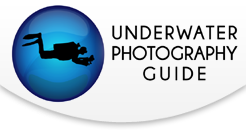
RECOMMENDED ARTICLES
SUPPORT THE UNDERWATER PHOTOGRAPHY GUIDE:
The Best Service & Prices on u/w Photo Gear
 Visit Bluewater Photo & Video for all your underwater photography and video gear. Click, or call the team at (310) 633-5052 for expert advice!
Visit Bluewater Photo & Video for all your underwater photography and video gear. Click, or call the team at (310) 633-5052 for expert advice!
The Best Pricing, Service & Expert Advice to Book your Dive Trips
 Bluewater Travel is your full-service scuba travel agency. Let our expert advisers plan and book your next dive vacation. Run by divers, for divers.
Bluewater Travel is your full-service scuba travel agency. Let our expert advisers plan and book your next dive vacation. Run by divers, for divers.




